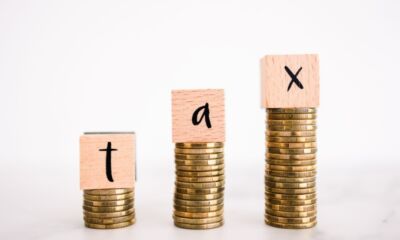What happens if you don’t claim the tax-free threshold?
The tax-free threshold is an amount of money you can earn each financial year without needing to pay tax. Here’s an overview of how it works.

The tax-free threshold is an amount of money you can earn each financial year without needing to pay tax. Here’s an overview of how it works.
KEY POINTS
- The current tax-free threshold applies to the first $18,200 of your income.
- If you don’t apply for the tax-free threshold, you will more than likely pay more tax during the financial year. This excess tax, however, will be returned to you when you do your tax return.
- The tax-free threshold does not apply to your Superannuation Guarantee (SG) contributions.
What is the tax-free threshold
If you’re an Australian resident with a tax file number (TFN), the tax-free threshold could help reduce how much income tax you need to pay. According to the Australian Taxation Office (ATO), the tax-free threshold is $18,200. This means if you’re an Australian resident for tax purposes, the first $18,200 of your income each financial year is tax-free and you only pay tax if you earn above this amount.
How do I claim the tax-free threshold?
Claiming the tax-free threshold is normally fairly simple. Whenever you start a new job or apply for a new Centrelink payment, you’ll be given a ‘tax file number declaration’ form to complete. All you have to do is answer ‘Yes’ to the question ‘Do you want to claim the tax-free threshold from this payer?’
Can I claim the tax-free threshold on more than one job?
Generally not. Standard practice is to only claim the tax-free threshold on one job at a time. According to the ATO, for people with two or more income sources in the same financial year, they require that you only claim the tax-free threshold from the payer who usually pays the highest salary or wage.
Only if you’re certain your total annual income from all payers will be less than $18,200 can you claim the tax-free threshold from each payer. However, if your income ends up being more than $18,200 for the year, you would then need to fill out a withholding declaration form and give it to one of your employers, to tell them you aren’t claiming the tax-free threshold from it anymore. If you don’t do this, you may end up being undertaxed, which would mean you’d have a tax bill to pay at the end of the financial year.
On the other hand, if you claim the tax-free threshold from only one employer, your second income stream and any other sources of income beyond that will be taxed at the higher, ‘no tax-free threshold’ rate. The ATO notes that this may possibly lead to you being overtaxed during the year, but that any excess withheld funds will be returned to you at the end of the financial year in the form of a tax refund once you do your tax return.
What happens if I don’t claim the tax-free threshold?
If you don’t claim the tax-free threshold at all for a financial year, then you may have to pay income tax on all the money you make. This would most likely result in you paying more tax than you need to during the year, since Australia’s income tax brackets and rates (as shown in the table below) assume you do claim the tax-free threshold to avoid paying tax on the first $18,200 you earn.
← Mobile/tablet users, scroll sideways to view full table →
| Total taxable income |
Tax rate |
|---|---|
| $0 – $18,200 | No tax |
| $18,201 – $45,000 | 16c for each $1 over $18,200 |
| $45,001 – $135,000 | $4,288 plus 30c for each $1 over $45,000 |
| $135,001 – $190,000 | $31,288 plus 37c for each $1 over $135,000 |
| $190,001 and over | $51,638 plus 45c for each $1 over $190,000 |
Source: ATO, 2025, effective for Australian residents in the 2024/25 financial year. The above rates do not include the Medicare Levy of 2%.
The ATO will most likely give this overpaid tax back to you as a refund once you do your tax return, but this would still mean you pay more upfront tax during the year. The ATO adds that you can fill out a PAYG withholding variation application form if you want to reduce how much tax gets taken out of your pay packet going forward.
How does the tax-free threshold apply to PAYG tax?
The yearly tax-free threshold rate of $18,200 is useful to be aware of when you’re doing your annual tax return, but it may not be particularly helpful if you want to figure out whether you need to make pay-as-you-go (PAYG) tax instalment payments on your regular income. Instead, the equivalent tax-free cut offs that apply to regular earnings could be useful to know about. Based on ATO figures, these are:
- If you’re paid weekly, you’ll pay tax on any earnings above $350
- If you’re paid fortnightly, you’ll pay tax on any earnings above $700
- If you’re paid monthly, you’ll pay tax on any earnings above $1,517.
You can also use Canstar’s income tax calculator to get an idea of the tax you’ll pay on your annual income.
It’s important to note, however, that your employer typically won’t automatically apply the tax-free threshold to your earnings. As the ATO states, it’s something you have to actively claim when you start a new job or apply for a Services Australia (Centrelink) payment, otherwise PAYG tax will be calculated from the first dollar, regardless of how much or how little you earn.
Can I claim the tax-free threshold if I’m not an Australian resident?
Foreign residents cannot claim the tax-free threshold. Instead, the ATO lists specific tax rates for foreign residents, starting at 30 cents for each $1 of income earned in Australia (up to $135,000). Higher tax rates apply for incomes above $135,000.
How does the tax-free threshold work with superannuation?
The tax-free threshold only applies to your taxable income and does not include income associated with Superannuation Guarantee (SG) contributions made by your employer. These contributions are taxed by the ATO once they reach your superannuation account at a rate of 15% according to the Federal Government’s Moneysmart website.
Can I claim the tax-free threshold if I’m under 18?
You can claim the tax-free threshold if you’re under 18 and are considered an ‘excepted person’ by the ATO. This means you’re either a full time worker or receive certain income related to having a disability or not being financially reliant on your relatives. Minors classified as excepted people are subject to the same tax rates as adults.
Under 18s who are not classified in this way are subject to different tax rates, as shown below:
Tax rates for Australian residents who are under 18 (not excepted people)
← Mobile/tablet users, scroll sideways to view full table →
| Total taxable income |
Tax rate |
|---|---|
| $0 – $416 | Nil |
| $417 – $1,307 | Nil plus 66% of the excess over $416 |
| Over $1,307 | 45% of the total amount of the income that is not excepted income |
Source: ATO, 2025, effective for Australian residents who are aged under 18 in the 2024/25 financial year.
 Online rollover
Online rollover
 Online application
Online application
 Online rollover
Online rollover
 Online application
Online application
 Online rollover
Online rollover
 Online application
Online application
 Online rollover
Online rollover
 Online application
Online application
 Online rollover
Online rollover
 Online application
Online application
Canstar may earn a fee for referrals from its website tables and from Promotion or Sponsorship of certain products. Fees payable by product providers for referrals and Sponsorship or Promotion may vary between providers, website position, and revenue model. Sponsorship or Promotion fees may be higher than referral fees.
On our ratings results, comparison tables and some other advertising, we may provide links to third party websites. The primary purpose of these links is to help consumers continue their journey from the ‘research phase’ to the ‘purchasing’ phase. If customers purchase a product after clicking a certain link, Canstar may be paid a commission or fee by the referral partner. Where products are displayed in a comparison table, the display order is not influenced by commercial arrangements and the display sort order is disclosed at the top of the table.
Sponsored or Promoted products are clearly disclosed as such on the website page. They may appear in a number of areas of the website, such as in comparison tables, on hub pages, and in articles. The table position of the Sponsored or Promoted product does not indicate any ranking or rating by Canstar.
Sponsored or Promoted products table
- Sponsored or promoted products that are in a table separate to the comparison tables in this article are displayed from lowest to highest annual cost.
- Performance figures shown for Sponsored or Promoted products reflect net investment performance, i.e. net of investment tax, investment management fees and the applicable administration fees based on an account balance of $50,000. To learn more about performance information, click here.
- Please note that all information about performance returns is historical. Past performance should not be relied upon as an indicator of future performance; unit prices and the value of your investment may fall as well as rise.
Cover image source: faithie/Shutterstock
This article was reviewed by our Finance Editor Jessica Pridmore before it was updated, as part of our fact-checking process.

Nick’s role at Canstar allows him to combine his love of the written word with his interest in finance, having learned the art of share trading from his late grandfather. Nick strives to deliver clear and straightforward content that helps the everyday consumer navigating the world of finance. Nick is also working on a TV series in his spare time. You can connect with Nick on LinkedIn.
- What is the tax-free threshold
- How do I claim the tax-free threshold?
- Can I claim the tax-free threshold on more than one job?
- What happens if I don’t claim the tax-free threshold?
- How does the tax-free threshold apply to PAYG tax?
- Can I claim the tax-free threshold if I’m not an Australian resident?
- How does the tax-free threshold work with superannuation?
- Can I claim the tax-free threshold if I’m under 18?
Try our Superannuation comparison tool to instantly compare Canstar expert rated options.






